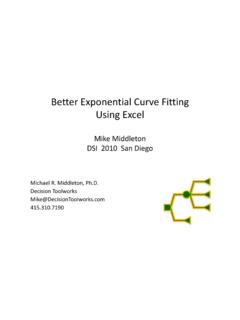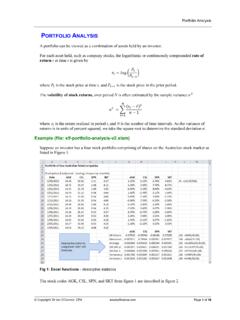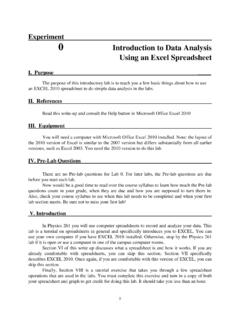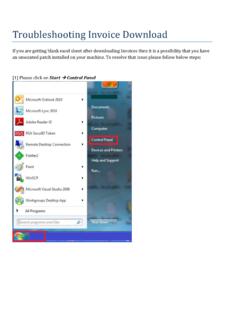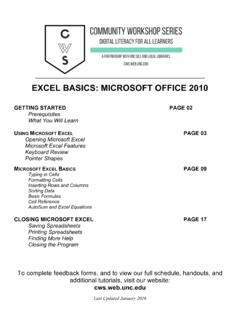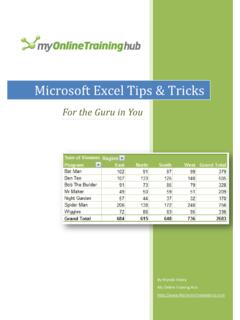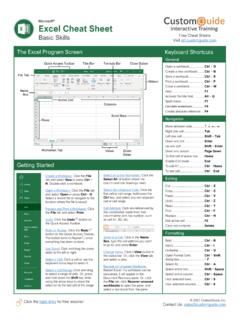Transcription of Better Exponential Curve Fitting Using Excel
1 Better Exponential Curve Fitting Using Excel Mike Middleton DSI 2010 San Diego Michael R. Middleton, Decision Toolworks Background The Exponential function, Y=c*EXP(b*x), is useful for Fitting some non-linear single-bulge data patterns. In Excel , you can create an XY (Scatter) chart and add a best-fit trendline based on the Exponential function. Problem: Regarding the fitted Curve for Excel s Exponential Trendline, (1) the reported value for R Squared is incorrect, and (2) the fitted values do not minimize Sum of Squared Deviations. DSI 2010 San Diego 2 Data from example originally presented in Winston (2004) Model for growth of Cisco revenue during 1900-1999 Potentially useful for projecting revenues and determining company value For 1900-1999, Cisco revenue seems to grow by approximately the same percentage each year The Exponential function, Y=c*EXP(b*X), has the property that for each unit increase in X the value of Y increases by a constant percentage Cisco Revenue Example DSI 2010 San Diego 3 In Excel 2010 , select data A4:B13.
2 Insert XY Scatter chart. Use Chart Tools Layout to add chart title and axes titles. Right-click a data point to select the data series, and choose Add Trendline from the shortcut menu. Cisco Data and XY Chart 123456789101112131415161718 ABCDEFGHI$ MillionsYearRevenueXY1$702$1833$3404$649 5$1,2436$1,9797$4,0968$6,4409$8,45910$12 ,154$0$5,000$10,000$15,000$20,0000246810 Revenue, in MillionsYearCisco Annual Revenue, 1990-1999 DSI 2010 San Diego 4 Trendline Dialog Box DSI 2010 San Diego 5 Excel Chart with Exponential Trendline 123456789101112131415161718 ABCDEFGHI$ MillionsYearRevenueXY1$702$1833$3404$649 5$1,2436$1,9797$4,0968$6,4409$8,45910$12 ,154y = = $0$5,000$10,000$15,000$20,0000246810 Revenue, in MillionsYearCisco Annual Revenue, 1990-1999 Next, compute the fitted values for Y, and use worksheet functions and formulas to compute the actual value of R Squared DSI 2010 San Diego 6 Actual R Squared for Exponential Trendline Excel s Trendline reports R Squared = Actual R Squared = Approximately 80% of the variation in Y is explained by X Using the fitted Exponential function 12345678910111213 ABCDEFGH$ MillionsExponential TrendlineYearRevenueXYFitted Y1$70$103SS Total156,733,316 Total SS2$183$183SS Regression125,667,007 Explained SS3$340$323SS Residual31,066,309 Unexplained SS, SSD4$649$5715$1,243$1,009R SS / Total SS6$1,979$1,7837$4,096$3,151 StDev(Residuals)
3 $1,7638$6,440$5,5689$8,459$9,84010$12,15 4$17,389 DSI 2010 San Diego 7 Shortcut Excel functions for R Squared calculations Note that we cannot use Excel s worksheet functions RSQ or PEARSON^2 or CORREL^2 to compute R Squared because those functions are based on a linear fit between Y and X. 12345678910111213 ABCDEFGH$ MillionsExponential TrendlineYearRevenueXYFitted Y1$70$103SS Total=COUNT(B4:B13)*VARP(B4:B13)Total SS2$183$183SS Regression=F4-F6 Explained SS3$340$323SS Residual=SUMXMY2(B4:B13,C4:C13)Unexplain ed SS, SSD4$649$5715$1,243$1,009R Squared=F5/F4 Explained SS / Total SS6$1,979$1,7837$4,096$3,151 StDev(Residuals)=SQRT(F6/COUNT(B4:B13))8 $6,440$5,5689$8,459$9,84010$12,154$17,38 9 DSI 2010 San Diego 8 Setup display for Better fit Using Excel s Solver Tentative values for coefficients in E2:F2 (Solver Changing Cells ) Formula for fitted value in C4 depends on coefficients and X, copied to C5.
4 C13 Sum of Squared Deviations formula in F6 (Solver Objective ) to be minimized 12345678910111213 ABCDEFGH$ MillionsCoeff cCoeff *EXP(b*X)1$70$103SS Total156,733,316 Total SS2$183$183SS Regression125,666,623 Explained SS3$340$323SS Residual31,066,693 Unexplained SS, SSD4$649$5715$1,243$1,009R SS / Total SS6$1,979$1,7837$4,096$3,151 StDev(Residuals)$1,7638$6,440$5,5689$8,4 59$9,84010$12,154$17,389 DSI 2010 San Diego 9 Setup formulas for Better fit Using Excel s Solver Tentative values for coefficients in E2:F2 (Solver Changing Cells ) Formula for fitted value in C4 depends on coefficients and X (absolute references to E2:F2, relative reference to A4), copied to C5:C13 Sum of Squared Deviations formula in F6 (Solver Objective ) to be minimized 12345678910111213 ABCDEFGH$ MillionsCoeff cCoeff *EXP(b*X)1$70=$E$2*EXP($F$2*A4)SS Total=COUNT(B4:B13)*VARP(B4:B13)Total SS2$183=$E$2*EXP($F$2*A5)SS Regression=F4-F6 Explained SS3$340=$E$2*EXP($F$2*A6)SS Residual=SUMXMY2(B4:B13,C4:C13)Unexplain ed SS, SSD4$649=$E$2*EXP($F$2*A7)5$1,243=$E$2*E XP($F$2*A8)R Squared=F5/F4 Explained SS / Total SS6$1,979=$E$2*EXP($F$2*A9)7$4,096=$E$2* EXP($F$2*A10)StDev(Residuals)=SQRT(F6/CO UNT(B4.))
5 B13))8$6,440=$E$2*EXP($F$2*A11)9$8,459=$ E$2*EXP($F$2*A12)10$12,154=$E$2*EXP($F$2 *A13)DSI 2010 San Diego 10 Excel 2010 Solver Parameters Dialog Box DSI 2010 San Diego 11 Excel 2010 Solver Options Dialog Boxes DSI 2010 San Diego 12 Results for Exponential Fit Using Solver Excel s Trendline reported R Squared = , but its actual R Squared = and StDev(Residuals) = $1,763 Solver s Better fit has actual R Squared = and StDev(Residuals) = $446 12345678910111213 ABCDEFGH$ MillionsCoeff cCoeff *EXP(b*X)1$70$325SS Total156,733,316 Total SS2$183$488SS Regression154,746,736 Explained SS3$340$732SS Residual1,986,580 Unexplained SS, SSD4$649$1,0985$1,243$1,648R SS / Total SS6$1,979$2,4717$4,096$3,707 StDev(Residuals)$4468$6,440$5,5609$8,459 $8,33910$12,154$12,509 DSI 2010 San Diego 13 Visual Comparison of Fits $0$2,000$4,000$6,000$8,000$10,000$12,000 $14,000$16,000$18,0000246810 Revenue, in Millions Year Cisco Annual Revenue, 1990-1999 Trendline Solver DSI 2010 San Diego 14 Comparison of Current/Previous Ratios $ MillionsR^2= , SD(Resid)=$1763R^2= , SD(Resid)=$446 YearRevenueActualTrendline ExponentialSolver Fit ExponentialXYCurrent/PreviousFitted YCurrent/PreviousFitted YCurrent/Previous1$70$103$3252$ $ $ $ $ $ $ $ $1, $1, $1, $1, $1, $1, $2, $4, $3, $3, $6, $5, $5, $8, $9, $8, $12, $17, $12, Ratio, 2 to Ratio, 3 to Ratio, 8 to 2010 San Diego 15 Excel s Method for Fitting Exponential Trendline, 1 of 2 The Exponential model creates a trendline Using the equation y = c * ebx.
6 Excel uses a log transformation of the original y data to determine fitted values, so the values of the dependent variable in your data set must be positive.. The Exponential trendline feature does not find values of b and c that minimize the sum of squared deviations between actual y and predicted y (= c * ebx). Instead, Excel 's method takes the logarithm of both sides of the Exponential formula, which then can be written as Ln(y) = Ln(c) + b * x and uses standard linear regression with Ln(y) as the dependent variable and x as the explanatory variable. That is, Excel finds the intercept and slope that minimize the sum of squared deviations between actual Ln(y) and predicted Ln(y), Using the formula Ln(y) = Intercept + Slope * x. Therefore, the Intercept value corresponds to Ln(c), and c in the Exponential formula is equal to Exp(Intercept).
7 The Slope value corresponds to b in the Exponential formula. - Middleton (1995) DSI 2010 San Diego 16 Excel s Method for Fitting Exponential Trendline, 2 of 2 XYLn(Y) = c*EXP(b*X)LN(Y) = LN(c) + b*XFit: LN(Y) = + *Xb = = EXP(LN(c))c = EXP( )c = (Y), Ln(Revenue)X, YearPlot of Ln(Y) vs XLn(y) = + = (Y), Ln(Revenue)X, YearLinear Fit for Ln(Y) vs XDSI 2010 San Diego 17 General Steps for Curve Fitting Goal: explain variation in a variable of interest, Y Prepare a histogram for Y, the dependent (or response) variable Find data for explanatory variable(s) that make sense Look at the data: plot XY (Scatter) charts to see relationships Propose a functional form for the relationship, based on knowledge of the underlying process, visual examination of the plot, parsimony, etc. Determine values for the parameters of the function best fit, minimize sum of squared deviations answers the question: What is the relationship?
8 Perform diagnostics, , R Squared, StDev(Residuals), etc. answers the question: How good is the relationship? Use the function prediction for cross-sectional data, mostly interpolation forecasts for time-series data, mostly extrapolation DSI 2010 San Diego 18 Summary of Excel Trendline Options Exponential : Y=c*EXP(b*X), transforms data before fit, not the best fit, inaccurate R Squared Linear: Y=b0+b1*X, OK Logarithmic: Y = c*LN(X)+b, OK Polynomial: Y=b0+b1*X1+b2*X2+.., OK Power: Y = c*X^b, transforms data before fit, not the best fit, inaccurate R Squared Moving Average: OK, but non-standard diagnostics DSI 2010 San Diego 19 Excel s Method for Fitting Power Trendline DSI 2010 San Diego 20 The power model creates a trendline Using the equation y = c * xb. Excel uses a log transformation of the original x and y data to determine fitted values, so the values of both the dependent and explanatory variables in your data set must be positive.
9 The power trendline feature does not find values of b and c that minimize the sum of squared deviations between actual y and predicted y (= c * xb). Instead, Excel 's method takes the logarithm of both sides of the power formula, which then can be written as Ln(y) = Ln(c) + b * Ln(x), and uses standard linear regression with Ln(y) as the dependent variable and Ln(x) as the explanatory variable. That is, Excel finds the intercept and slope that minimize the sum of squared deviations between actual Ln(y) and predicted Ln(y), Using the formula Ln(y) = Intercept + Slope * Ln(x). Therefore, the Intercept value corresponds to Ln(c), and c in the power formula is equal to Exp(Intercept). The Slope value corresponds to b in the power formula. References Middleton, 1995. Data Analysis Using Microsoft Excel Duxbury Press, Belmont, CA. Winston, 2004.
10 Microsoft Excel Data Analysis and Business Modeling. Microsoft Press, Redmond, WA. DSI 2010 San Diego 21 Better Exponential Curve Fitting Using Excel Mike Middleton, DSI 2010 San Diego Michael R. Middleton, Decision Toolworks PowerPoint Slides, Slides PDF File, and Excel Workbook
